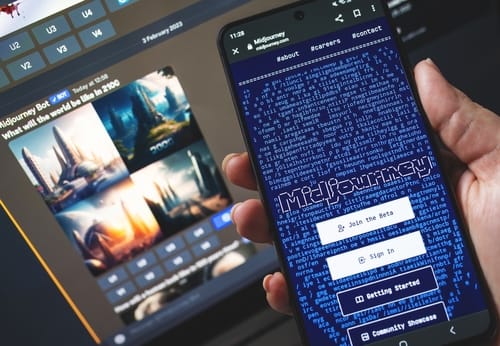How to create a brand identity in 2024 that's memorable (and loved)
What does it take to create a memorable and beloved brand identity in 2024? Learn how to stand out and captivate your audience with these expert tips.
 August 28, 2023
August 28, 2023 12 minute reading
12 minute reading
If you want long-term success and recognition, building a memorable brand identity is the way to go. A strong brand identity not only sets the brand name apart from competitors, but also fosters customer loyalty and establishes an emotional connection with the target audience.
This involves carefully crafting a unique and cohesive representation of the brand's values, personality, and offerings.
You can set your brand up for success by creating a unique brand identity. We spoke to over forty SMB owners and brand marketing specialists to find out how.
Let’s get started.
Hire an expert designer for your brand identity on Fiverr
What is brand identity?
Brand identity is the full representation of a brand that sets it apart from its competitors. It includes the visual, verbal, and experiential components that reflect the brand's personality, purpose, and values.
Here are the major components of a successful brand identity.
Logo: Your logo design is the distinctive visual symbol that represents the brand and is easily recognizable
Colors: A carefully curated color palette with a few key brand colors or color scheme. It conveys the brand's personality and evokes specific emotions or associations.
Typography: The choice of fonts, typeface, and typography styles used consistently across brand communications to create a cohesive visual identity.
Visual elements: Graphic or design elements such as icons, patterns, or imagery that support the brand identity design and contribute to its overall look and feel.
Tone of voice: The style and manner of communication used in written and verbal brand messaging, reflecting the brand's personality and values.
Messaging: The core brand messages, taglines, and slogans that communicate the brand's value proposition and key attributes.
Packaging and product design: The design and aesthetics of the brand's products or packaging, which should align with the overall brand identity. This extends to all marketing materials, such as business cards, presentation templates, and infographics.
Brand guidelines: A guide for the consistent application of the brand identity across different touchpoints, ensuring visual and verbal brand awareness. This can also be called a brand style guide, which details all the visual elements of brand assets.
A strong brand identity helps in creating recognition and loyalty among consumers. It serves as a foundation for consistent brand communication and is a vital asset for businesses in differentiating themselves in the marketplace.
How to create a brand identity? Top 12 proven tips to create a unique brand identity
Building a brand identity that stands out and captivates consumers' hearts is more crucial than ever. In 2023, where competition is fierce and consumer preferences rapidly change a memorable and loved brand identity can be the key to success. To help you create an impactful brand identity, we've compiled 12 proven tips backed by examples and statistics:
1. Define your brand's purpose
A clear and compelling brand purpose drives loyalty and engagement. However, a brand's purpose isn’t just about making a profit. It’s about defining what the brand stands for, what it hopes to achieve, and how it wants to make a positive impact on the world.
According to a Salsify survey,46% of consumers in the United States say that they are willing to pay more to purchase products from brands they trust. This sentiment is shared by a similar percentage of consumers in other major markets, including Great Britain and France.
When looking for examples of brands that have a great brand purpose—TOMS Shoes is a great one, with its "One for One" giving model. TOMS donates a pair of shoes to a child in need with every pair of shoes purchased, building a loyal customer base, and amplifying its reach.

TOMS shoes with a tag that reads, ‘With every paid you purchase, TOMS will give a pair of new shoes to a child in need. One for One.’
This not only provides buyers with a compelling reason to choose TOMS, but also effectively fulfills the company's mission statement of making a positive impact on the world.
2. Understand your target audience
Market research your target audience and demographics thoroughly to understand their needs, preferences, and pain points. You can do this via surveys, focus groups, or by using social media listening tools. Tailor your messages and marketing initiatives after analyzing your target market. This way you’ll create messages that resonate with them.
Airbnb is a brand that focuses on catering to its audience's desire for unique travel experiences, leading to remarkable customer loyalty. According to an Airbnb survey,83 percent of respondents are in favor of relocating as part of remote working.
One of the ways travelers are taking advantage of this trend is by trying before they buy–turning to Airbnb to test new neighborhoods and cities before making a long-term commitment. This has helped Airbnb to stand out in a crowded market and build a community of passionate users.
By understanding their target audience and delivering on their needs, Airbnb has been able to create a brand that people love and trust—as well as tap into potential customers.
3. Develop a unique brand personality
According to Stackla,88 percentof consumers say that authenticity is a key factor when deciding what brands they like and support.
Consumers want brands that they can relate to, and seem authentic. That’s why you should craft a brand personality that aligns with your target audience's values and aspirations.
For example, Red Bull hones an exciting, daring, spirited, or imaginative personality. According to theAeker Model of brand personality dimensions, ‘Excitement’ brands are bold, creative, and spirited, like Red Bull or Tesla.
“Many ecommerce owners think brand personality and brand identity are the same, but they are not,” says Ryan Rottman, Co-Founder & CEO of OSDB, a professional sports database. “You can have a great product, but if your overall voice is cold or disconnected from the human elements that attract people, the likelihood is that your target audience will have a difficult time identifying with your brand.”
4. Leverage storytelling
Powerful storytelling creates an emotional connection with consumers. By narrating your brand story, you can convey values, mission, and personality in a way that resonates with your audience.
For instance, Nike's "Just Do It" campaign has been very successful in inspiring and motivating people worldwide for years.
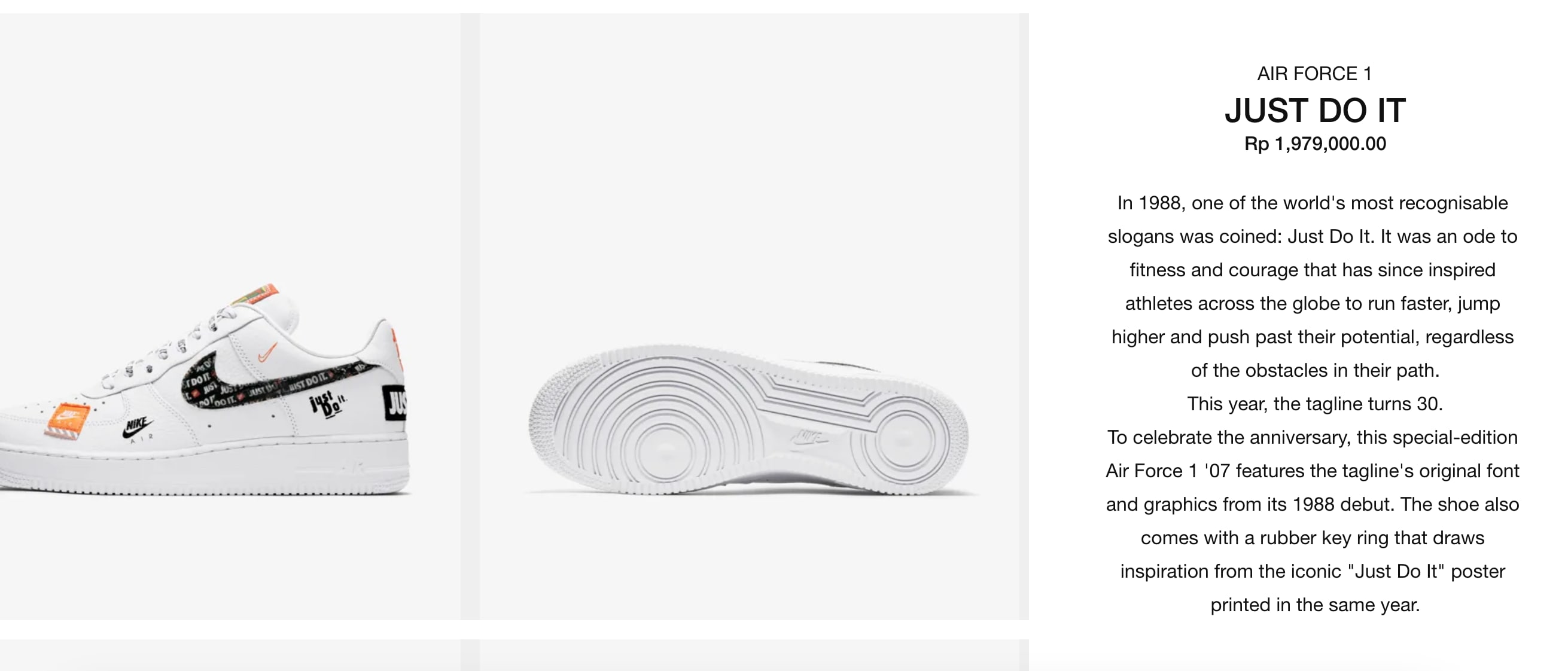
Nike’s Air Force 1 ‘07 with ‘Just Do It’ original graphics
The story behind the campaign is that all of us have the potential to achieve great things if only we take action to achieve our goals. This message has resonated with consumers worldwide and has helped to build Nike's brand identity as a company that encourages people to pursue their dreams and reach their full potential.
5. Design an eye-catching logo
Your logo is the visual representation of your brand and plays an important role in establishing visual brand identity and recognition. According to a study, 75% of people recognize a brand by its logo.
It serves as a visual representation of a company, product, or service and is often the first thing that comes to mind when people think about a particular brand.
That’s why good graphic design is essential for a logo, aiming for simplicity and distinctiveness to leave a lasting impression on consumers.
Hiring a freelance logo graphic designer can help you create something unique that attracts customers. You can also use AI image generators like Midjourney to work on your logo.
If you’re a new brand or a small business startup, brainstorming and creating a unique logo can prevent an expensive rebrand in the future.
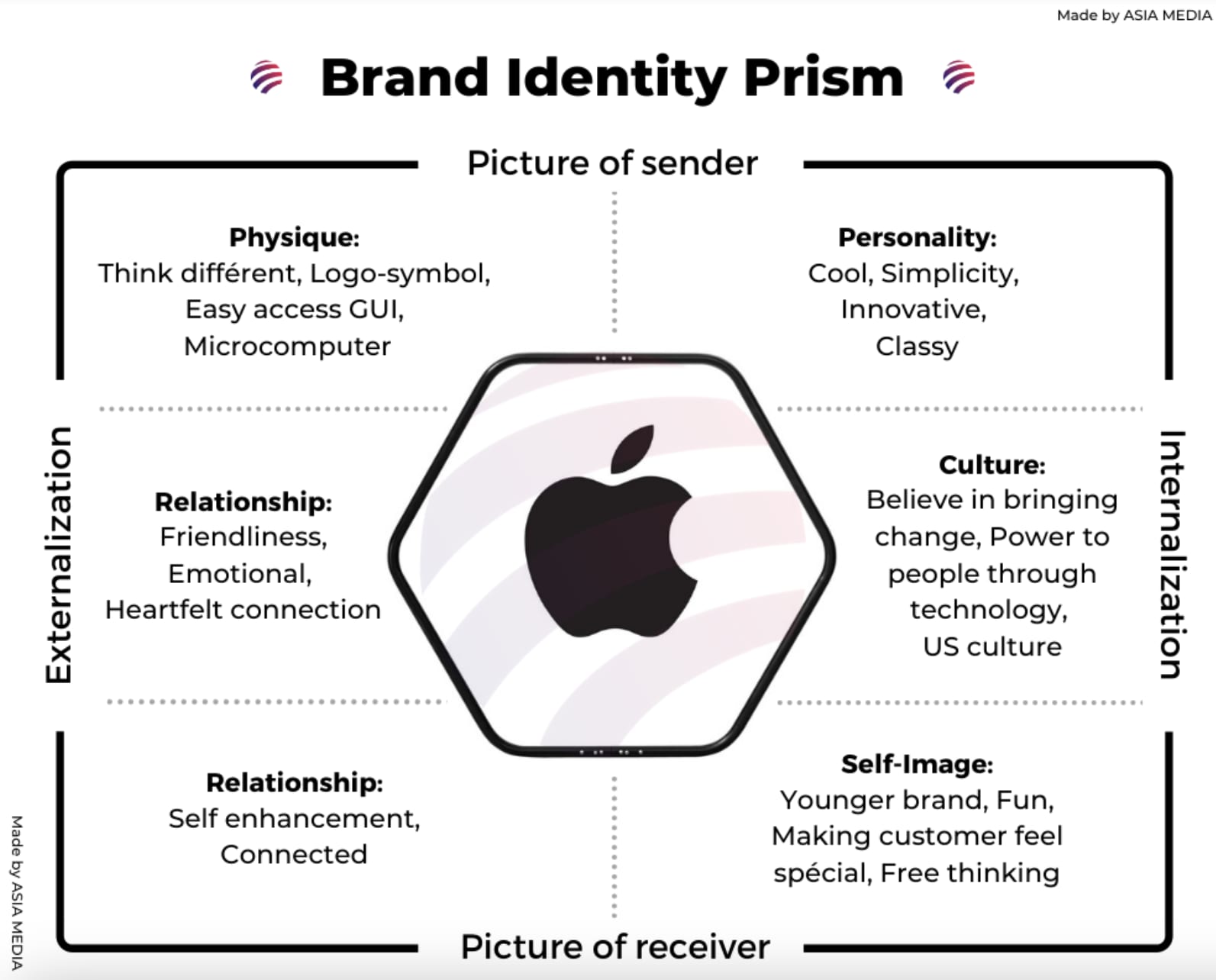
Brand Identity Prism by Asia Media, infographic on brand physique, personality, relationship, culture, and self-image.
Apple's iconic logo is a great example. It features a simple, stylized apple silhouette, is instantly recognizable, and has become synonymous with the company itself.
6. Choose the right colors
Colors evoke emotions and can significantly impact brand perception. The impact of color on brand perception was studied extensively, and businesses strategically use colors to convey specific messages and create strong associations with their brands.
According to research, blue conveys trust (e.g., Facebook, IBM), while red can symbolize energy, positivity, and passion (e.g., Coca-Cola, Netflix).
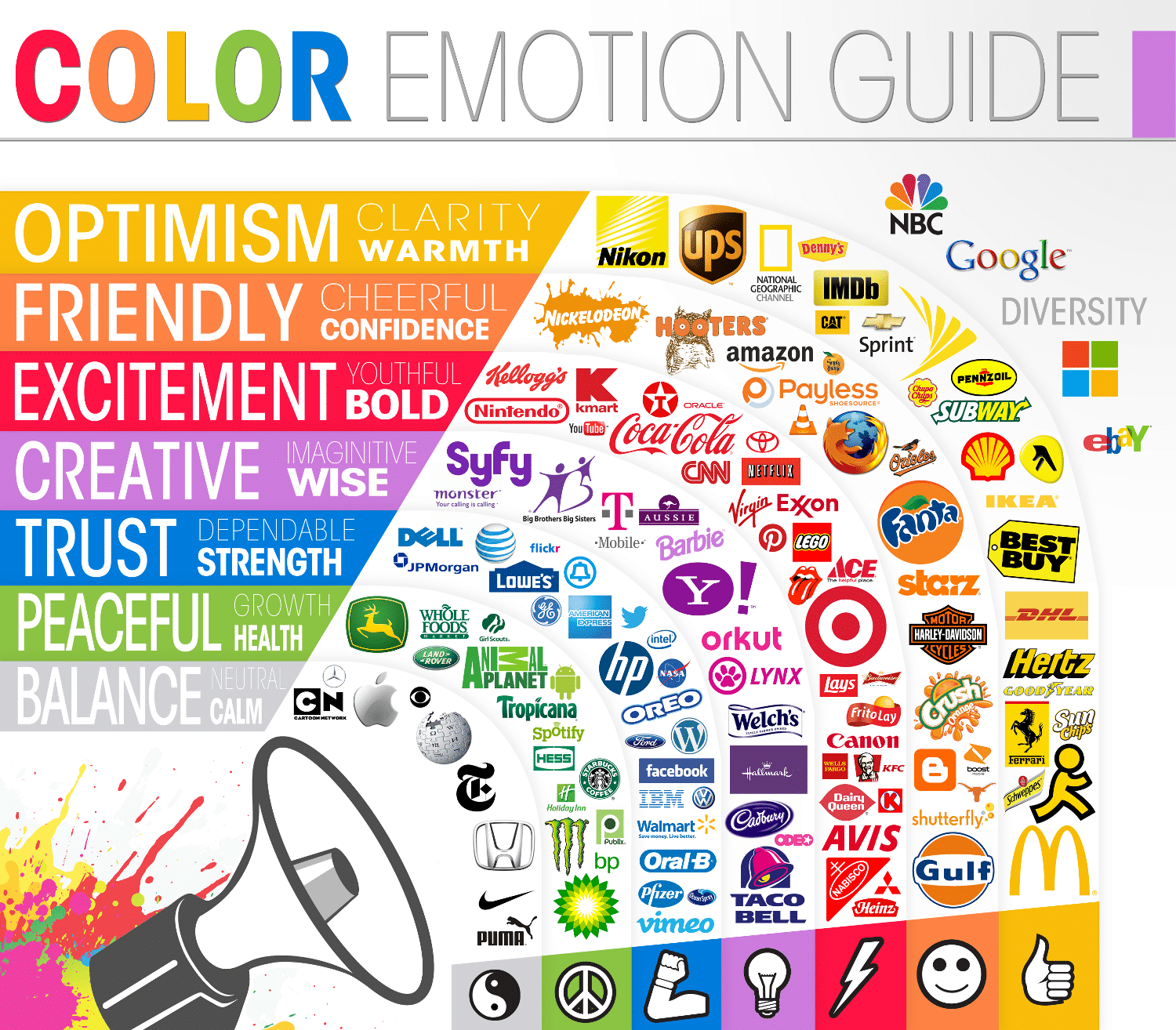
Brands and color emotions on yellow, orange, red, purple, blue, green, and grey.
Color psychology suggests that different colors can elicit various emotional responses and associations. Here are some common color associations and how they’re used in branding:
Blue signifies trust and professionalism, often employed by companies like Facebook and IBM to convey reliability.
Red represents energy and passion, creating a sense of urgency for brands like Coca-Cola and Netflix.
Green symbolizes nature and sustainability, emphasized by brands such as Starbucks and Whole Foods.
Yellow evokes warmth and happiness, utilized by McDonald's and IKEA to create a friendly image.
Black signifies luxury and elegance, adopted by high-end brands like Chanel.
Purple represents creativity and uniqueness, attracting imaginative audiences for brands like Cadbury and Yahoo.
Considering cultural differences is essential when selecting colors to ensure they align with the target audience. Consistency in color usage, as well as brand fonts across brand elements, fosters brand recognition.
7. Consistency across all touchpoints
Maintain consistency in your brand identity across all platforms and interactions. It means ensuring your brand's visual elements, messaging, tone of voice, and values remain consistent. All the interactions with platforms and audiences need to be uniform as well.
This consistency not only reinforces brand recognition, but also builds trust and credibility among consumers. According to a study, more than two-thirds (68 percent) of businesses say brand consistency has contributed to 10% or more in revenue growth.
“The inherent challenge with selling across multiple channels and even locations is that you're reaching different audiences who require, well, different targeting,” says Jara, Head of Marketing at Thrive, an inventory management tool. “You don't want to reinvent your brand for every market. Instead, develop strong brand values, voice, and mission that has enough room to be personalized for each audience.”
For instance, McDonald's maintains consistency in its branding by prominently featuring its golden arches logo across all touchpoints, reinforcing its identity and creating familiarity and trust among customers worldwide. The brand communicates consistent messaging and tone of voice that align with its core values across various channels.
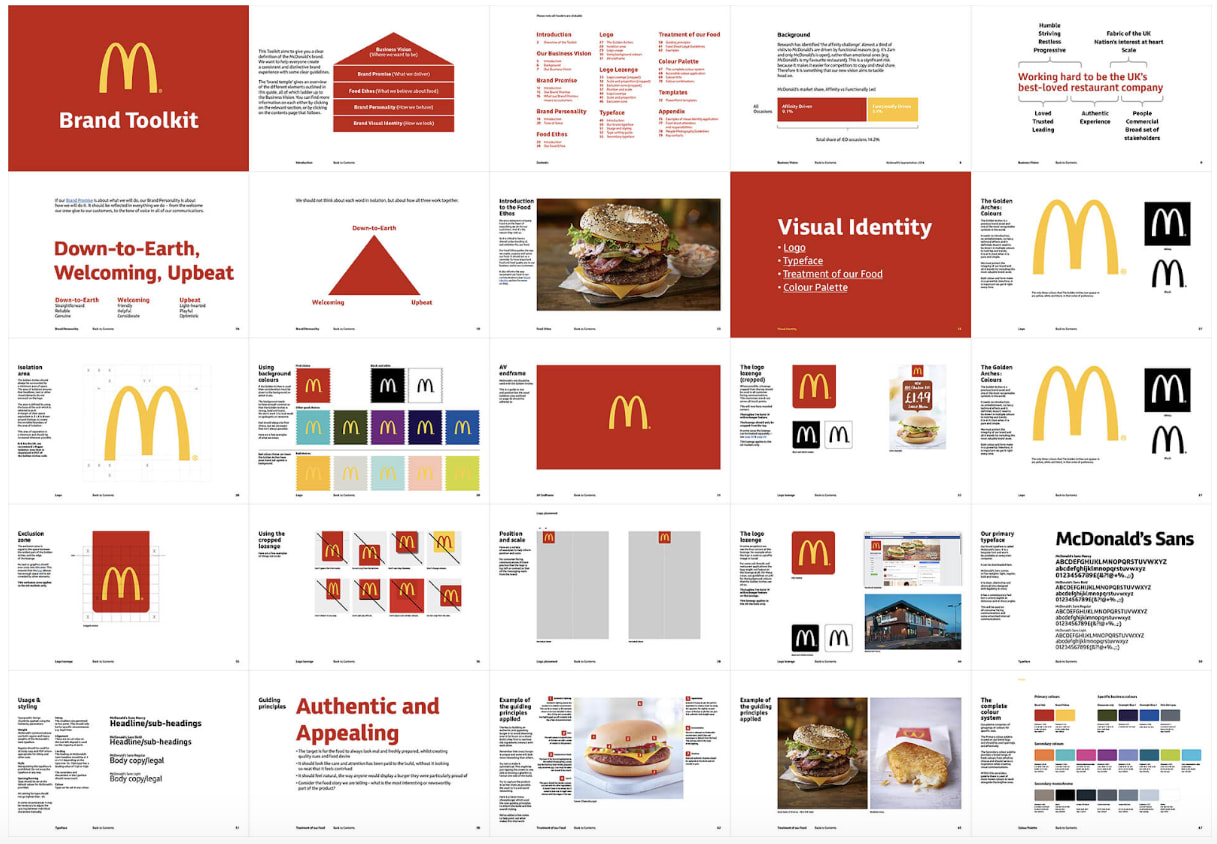
McDonald’s brand positioning, consistent logo, color scheme, and typography across channels.
It also strives to provide a consistent customer experience, ensuring the same standards of quality, cleanliness, and service across its global network of restaurants. By maintaining this consistency, McDonald's has built a solid and recognizable brand identity, establishing a global presence and reputation.
8. Engage with user-generated content (UGC)
UGC involves encouraging customers to create and share content related to the brand, such as photos, videos, reviews, and testimonials, on various social media platforms. When executed well, UGC campaigns can generate authentic and compelling content that resonates with a broader audience.
According to a study, 79% of people say UGC highly impacts their purchasing decisions. So you should encourage your customers to share their experiences with your brand through UGC.
The "White Cup Contest" by Starbucks was a successful UGC campaign launched in 2014. It encouraged customers to customize Starbucks' white coffee cups and share their designs on social media using the hashtag #WhiteCupContest.

Woman holding Starbucks white coffee cup decorated with black ink, #WhiteCupContest, 2014
Starbucks actively engaged with participants by liking, commenting, and reposting entries, fostering a sense of appreciation and recognition. Outstanding designs were featured on limited edition reusable cups. The campaign's success can be attributed to providing a creative outlet, inclusivity, creating social media buzz, and establishing a personal connection.
The contest exemplifies the power of UGC in engaging customers and building a sense of community while strengthening brand identity.
9. Embrace social media
Social media platforms provide an opportunity to humanize your brand and connect with your audience directly. Your social media marketing campaigns need to bring your brand personality to life.
Wendy's Twitter account, famous for its witty and humorous responses, has garnered significant attention and engagement. News and blogs published praises for Wendy’s savage tweets, creating further buzz.

Tweet by Wendy’s on #NationalRoastDay, calling its audience to roast the brand
Social media marketing goes beyond creating a brand identity, and also impacts your bottom line. According to this study, Instagram (47%), Facebook (38%), and YouTube (36%) are the social platforms people now look to most for their purchasing inspirations.
Creating social media content is easier in 2023 with AI. Content marketing teams can use AI video, AI art, and text-based software to ideate and execute campaigns like never before.
10. Create an exceptional customer experience
Deliver outstanding customer service to foster positive brand sentiment and word-of-mouth referrals. When customers have a positive experience with a brand, they’re more likely to develop a favorable perception, become loyal customers, and recommend the brand to others.
For instance, Zappos has gained a reputation for exceptional customer service by prioritizing the customer, providing 24/7 support, offering personalized interactions, maintaining a generous return policy, and surprising customers with thoughtful gestures.
This commitment to outstanding service has become a core part of Zappos' brand identity, leading to loyal customers and positive word-of-mouth referrals.
By consistently exceeding customer expectations, it has set a benchmark for customer service in the retail industry, demonstrating the importance of creating an exceptional customer experience for building a strong brand.
“You can have the most beautiful eye-catching brand identity in the world, but if the customer experience has been sub-optimal, then you will lose their loyalty and trust,” says Michael Nova, Director at Nova Custom Printing, a printing service. “Create a great experience working together with your customer, and you will naturally stick in their mind.”
11. Support social and environmental causes
Consumers are increasingly drawn to brands that show genuine concern for social and environmental issues. They’re not just looking for products or services; they want to support companies that demonstrate genuine concern for the greater good.
This shift in consumer behavior has paved the way for brands to embrace social and environmental responsibility as a core part of their business strategies.
Patagonia, a company dedicated to sustainability and environmental activism, has won a devoted following because of its values-driven approach.
Patagonia's brand identity revolves around environmental conservation and social responsibility. It prioritizes sustainable products, maintains transparency and ethical practices, engages in environmental activism, and commits to corporate philanthropy.
12. Measure and adapt
Regularly measure the impact of your brand identity initiatives and be prepared to adapt to changing consumer trends. Data analytics and customer feedback can help you refine your brand strategy for optimal results.
“We launched a marketing campaign that was centered around our brand identity—resulted in a tremendous response, propelling our sales by 40%,” says Kevin Wang, Co-owner at Inyouths LED Mirrors, a bespoke LED mirror company. “It further reinforced our recognition in the interior lighting market. Building an excellent, cohesive brand identity has been an investment with significant returns, contributing to our business growth.”
If you don’t stay appraised of how your audience is receiving your brand, it’s easy for your messaging to be tone-deaf. Use social monitoring tools to stay up-to-date on your brand voice.
What are the 5 pillars of brand identity?
The five pillars of brand identity are key components that contribute to the overall perception and recognition of a brand. They are:
Brand purpose: Defines its reason for existence beyond just selling products or services. It encapsulates the brand's mission, values, and the positive impact it seeks to make in the world. A strong brand purpose gives meaning to the brand and resonates with customers on a deeper level.
Brand positioning: Identifies and emphasizes the unique value proposition that sets the brand apart from competitors. Effective brand positioning focuses on the brand's strengths, target audience needs, and competitive advantages.
Brand personality: The set of human characteristics and traits that are attributed to a brand. It represents the brand's tone, style, and overall character, which helps to establish an emotional connection with consumers, and influences the way you can communicate and interact with your audience.
Brand visual identity: The visual elements that represent the brand. It includes the logo, color palette, typography, imagery, and overall design aesthetics. A well-crafted visual identity ensures consistency and will make your brand visually recognizable and memorable.
Brand voice and messaging: The style, tone, and language used in the brand's communications. It reflects the brand's personality and values. Consistent messaging helps to create a cohesive experience across various channels and touchpoints.
By establishing a strong foundation in these five pillars, you can effectively shape their identity, connect with your audience, and differentiate your brand in the market.
A brand identity differentiates your brand, builds recognition, fosters customer loyalty, and supports your overall business goals. It’s a worthy investment that pays off by creating a unique and memorable brand experience that resonates with your audience.
Hire an expert designer for your brand identity on Fiverr
A strong and well-defined brand identity will help your business stand out, build loyalty, and create a lasting impression in the minds of your audience. Ready to get started? Sign up on Fiverr today to buy services of a brand identity freelancer.


